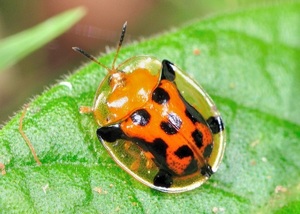Classical and new association biocontrol
When pests are to be controlled over large areas, the only long-term effective approach is introduction of natural enemies. If the target pest is an invasive non-native species and its natural enemies from its country of origin are introduced, the approach is called classical biological control. If the target is a native pest and the natural enemies released against it come from a different species, the approach is called new-association biological control.

Classical biological control
Asian citrus psyllid (ACP) was first detected in California in August 2008. In 2011, a host-specific parasitoid of ACP, Tamarixia radiata, was sourced from Punjab, Pakistan and released to help suppress urban ACP populations across southern California.

New-association biocontrol
The Acacia tortoise beetle (ATB) was first detected in New Zealand in 1996. In 2000, the Australian egg parasitoid Enoggera nassaui was released in the field to evaluate parasitism of ATB. Enoggera nassaui has no evolutionary history with ATB and is a new-association biocontrol agent.